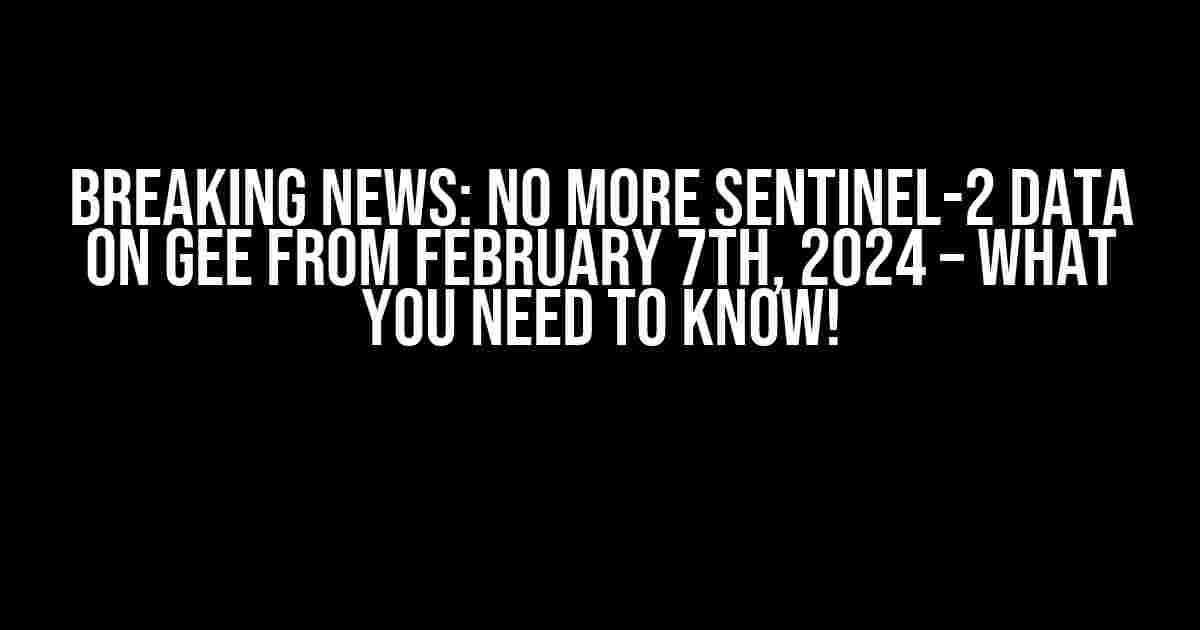Attention all Earth observation enthusiasts, researchers, and developers! If you’re relying on Google Earth Engine (GEE) for Sentinel-2 data, you’re in for a shock. As of February 7th, 2024, Sentinel-2 data will no longer be available on GEE. In this article, we’ll dive into the reasons behind this decision, its implications, and most importantly, provide you with alternative solutions to ensure a seamless transition.
The Why Behind the Withdrawal
So, why is GEE discontinuing Sentinel-2 data? The main reason lies in the ever-growing demand for data storage and processing power. With the increasing popularity of Sentinel-2, the data volume has become unsustainable for GEE’s infrastructure. The European Space Agency (ESA), the primary provider of Sentinel-2 data, has also been exploring alternative distribution channels to meet the rising demand.
Implications of the Withdrawal
The discontinuation of Sentinel-2 data on GEE will have far-reaching consequences for various stakeholders. Here are a few implications to consider:
- Disruption of workflows: For researchers, developers, and organizations relying on GEE for Sentinel-2 data, this change will disrupt their workflows and impact project timelines.
- Loss of access: Without access to Sentinel-2 data on GEE, users will need to find alternative sources or face the risk of delayed or incomplete projects.
- Increased costs: Depending on the new data sources, users might incur additional costs for data storage, processing, or subscription fees.
Alternative Solutions for Sentinel-2 Data
Fear not, dear users! While GEE might be discontinuing Sentinel-2 data, there are alternative solutions that can help you access this critical data. Here are a few options to consider:
ESA’s Copernicus Hub
The Copernicus Hub, operated by the ESA, is the official distribution platform for Sentinel-2 data. You can register for a free account and access the data directly from the source. The platform offers a range of tools and APIs for data discovery, download, and processing.
# Example API request to fetch Sentinel-2 data from Copernicus Hub
import requests
api_url = "https://scihub.copernicus.eu/dhus/api/collections/"
params = {"dataset": "S2MSI1C"}
response = requests.get(api_url, params=params)
if response.status_code == 200:
print("Data available!")
else:
print("Error fetching data.")
Amazon Web Services (AWS) Open Datasets
AWS Open Datasets provides access to Sentinel-2 data, along with other Earth observation datasets, for free. You can use the AWS CLI or SDKs to access the data and leverage AWS services for processing and analysis.
# Example command to list Sentinel-2 datasets on AWS Open Datasets
aws open-datasets list-datasets --query 'Datasets[?contains(Name, `Sentinel-2`)].{Name, ARN}'
Microsoft Planetary Computer
The Microsoft Planetary Computer is a global, cloud-based platform for Earth observation data and analytics. It offers Sentinel-2 data, along with other datasets, and provides tools for data processing, analysis, and visualization.
# Example code to access Sentinel-2 data on Microsoft Planetary Computer
from planetary_computer import Planet
pc = Planet()
dataset = pc.get_dataset("sentinel-2-l2a")
print(dataset.get_items())
Transitioning to Alternative Solutions
To ensure a seamless transition, follow these steps:
- Assess your data requirements: Evaluate your data needs and identify the most suitable alternative solution.
- Register for new accounts: Create accounts on the chosen platform (e.g., Copernicus Hub, AWS Open Datasets, or Microsoft Planetary Computer).
- Update your workflows: Adapt your workflows to integrate with the new data source, using APIs, SDKs, or CLIs provided by the platform.
- Test and validate: Verify that your workflows are functioning as expected with the new data source.
Conclusion
The discontinuation of Sentinel-2 data on GEE is a significant change, but with this article, you’re now equipped to navigate the transition. By understanding the reasons behind the withdrawal and exploring alternative solutions, you can ensure business continuity and keep your projects on track. Remember to plan ahead, assess your data requirements, and adapt to the new data sources to minimize disruptions.
| Alternative Solution | Data Access | Cost |
|---|---|---|
| Copernicus Hub | Free registration, API access | Free |
| AWS Open Datasets | API access, AWS CLI, SDKs | Free (data storage and processing costs apply) |
| Microsoft Planetary Computer | API access, SDKs | Free (data storage and processing costs apply) |
Stay ahead of the curve, and don’t let the discontinuation of Sentinel-2 data on GEE hinder your progress. Explore the alternative solutions, adapt to the changes, and continue to thrive in the world of Earth observation and remote sensing!
Here is the FAQ section about “No more Sentinel-2 data available on GEE from February 7th, 2024”:
Frequently Asked Question
We’ve got the scoop on the Sentinel-2 data unavailability on Google Earth Engine (GEE) from February 7th, 2024! Check out the FAQs below for the lowdown.
What’s going on with Sentinel-2 data on GEE?
As of February 7th, 2024, Sentinel-2 data will no longer be available on Google Earth Engine (GEE). This change is due to the European Space Agency’s (ESA) decision to discontinue the distribution of Sentinel-2 data through GEE.
What does this mean for my projects on GEE?
If you’re currently using Sentinel-2 data on GEE, you’ll need to find alternative sources or switch to a different data provider. We recommend exploring other options, such as the Copernicus Hub or the ESA’s own data dissemination platforms, to access Sentinel-2 data.
Can I still access historical Sentinel-2 data on GEE?
Yes, you’ll still be able to access historical Sentinel-2 data on GEE, up to February 7th, 2024. However, no new data will be added, and you won’t be able to access data after this date.
Why did the ESA decide to discontinue Sentinel-2 data on GEE?
The ESA made this decision due to the increasing demand for Sentinel-2 data and the need to maintain control over the data distribution. They want to ensure the data is used in accordance with their licensing terms and conditions.
What alternatives are available for accessing Sentinel-2 data?
You can access Sentinel-2 data through the Copernicus Hub, the ESA’s own data dissemination platforms, or other third-party providers. We recommend exploring these options to find the best fit for your needs.

